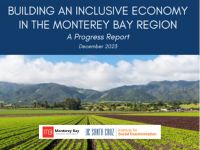Building an Inclusive Economy in the Monterey Bay Region
In this report, researchers from the Institute for Social Transformation, in partnership with the Monterey Bay Economic Partnership, aim to help community and business leaders throughout the Monterey Bay Area (Monterey, San Benito and Santa Cruz Counties) better understand the progress they are making towards a more inclusive economy.
Promoting inclusive economies has become an important goal in economic development strategies across the country and around the world. There is increasing recognition that inclusion is important not just for social and democratic goals, but also economic goals. There is now strong evidence that more equitable regions and countries have better economic performance. For this reason, there is a growing movement towards developing a more nuanced method of understanding our economy in a way that incorporates greater attention to ecological and social well-being.
This report was built upon a framework originally proposed by the Rockefeller Foundation and further refined by others at both a metropolitan and national scales. This approach recognizes five critical dimensions that are all important in developing an inclusive economy: Equitable, Participatory, Growing, Sustainable, and Stable.
While there are some encouraging signs, especially with regard to Sustainability, overall, the report reveals our region still faces many challenges in achieving inclusive economic development. Data suggests there are stark racial inequalities in our region concerning areas as diverse as income, wealth accumulation, educational attainment, voting, entrepreneurship, and self-employment. The report also highlights sharp disparities throughout our region in life expectancy, household consumption patterns, resilience in the face of economic uncertainty.
The authors hope that the data provided can be a basis for discussion and further investigation into the causes of these patterns, and help to develop strategies for addressing issues that these indicators may highlight. The authors also welcome any and all suggestions on how to make this kind of work even more useful going forward.

